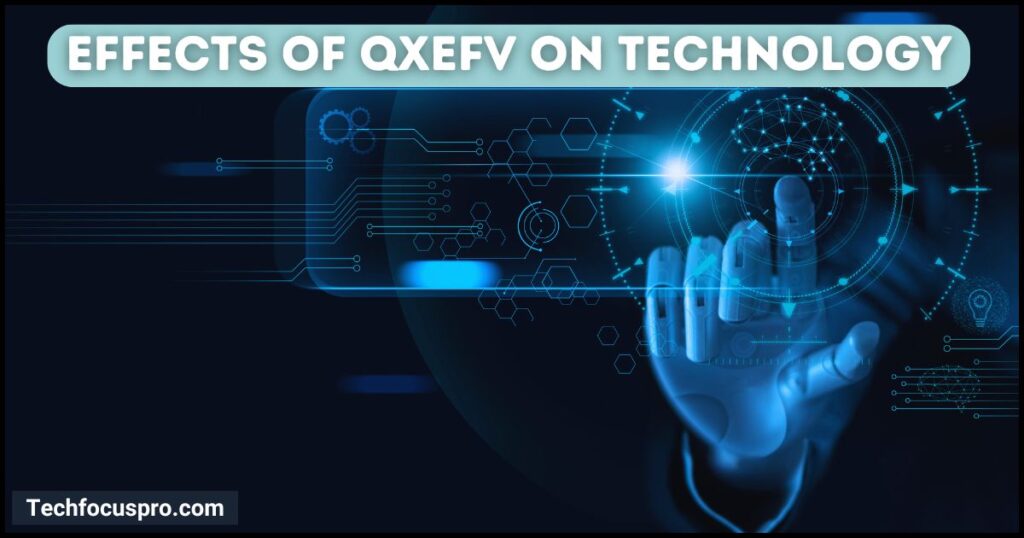QXEFV Guide | How it’s Changing and Future with Technology

In today’s fast-changing world, people expect more than just products or services—they want meaningful experiences. That’s where QXEFV comes in.
QXEFV is not just a measurement tool. It’s a powerful movement that’s changing how companies and technology connect with people. From apps and websites to healthcare, tech and education, QXEFV helps brands understand what truly matters to their customers.
This guide will show you how QXEFV is shaping the future of innovation, customer experience, and smart decision-making. If you want to stay ahead in business or tech, learning QXEFV is the next big step.
What is QXEFV?
QXEFV, or the “Quantitative Measurement of Experiential Value,” is a method businesses use to measure and understand the worth of the experiences they provide to their customers.
Instead of just looking at numbers and sales, QXEFV focuses on the quality of customer interactions and satisfaction.
It tries to put a quantitative value on qualitative aspects, like how happy or satisfied customers feel after using a product or service. This innovative approach helps companies sell more and build stronger customer relationships by enhancing their overall experience.
How to Calculate Your QXEFV Score
If you want to measure how good your customer experience really is, you can calculate a QXEFV score. This score helps you understand how users feel during different parts of their journey with your business like using your website, talking to support, or getting a delivery.
✅ Simple QXEFV Formula
QXEFV Score = (Σ Experience Ratings × Weight) / Number of Touchpoints
What Do the Core Ideas of QXEFV Mean?

The crux of QXEFV lies in two core principles: understanding the customer experience and quantifying that experience into tangible value. It postulates that an enhanced customer experience yields subjective gratification and measurable benefits, which businesses ignore at their peril.
Customer Experience (CX) encompasses every facet of the customer’s voyage with a product or service—starting from awareness and concluding with post-purchase engagement. The touchpoints along this trajectory are pivotal in shaping the overall experience and customer sentiment.
On the other hand, Quantitative Value (QV) focuses on concretizing the worth a customer attains through these experiences. This can be anything from monetary returns or time savings to quality enhancements. QXEFV proclaims, “If you can experience it, you can measure it.”
Foundational Elements of QXEFV
At its foundation, QXEFV is underpinned by the integration of CX and QV, which fuse into a potent amalgamation that empowers businesses to make informed, customer-centric decisions. This synergy is essential in today’s dynamic market conditions, where consumer tastes and preferences are as volatile as they are vital.
Quantifying Customer Experience: The first significant step in implementing QXEFV is breaking the customer experience into quantifiable parameters. This involves deconstructing every interaction into figures that reflect its impact on the customer.
Analyzing Quantitative Value: Once the experiential elements are broken down, these are converted into values. Whether a service’s convenience or a solution’s effectiveness, each attribute is assigned a tangible value contributing to the overall QV.
How Does QXEFV Work?

QXEFV is a theoretical concept and a framework backed by methodologies that include data collection, analysis, and application.
- Data Collection: Businesses employ various data collection techniques, from surveys and interviews to analytics tools and direct observation. The objective is to glean customer insights, preferences, and satisfaction rates.
- Statistical Analysis: Every bit of data is precious, but only when subjected to rigorous analysis can it unveil actionable trends. Sophisticated statistical tools come into play here, delineating correlations and causations that can guide strategic decision-making.
- Application to Business Strategy: Strategies born from QXEFV insights can range from customer service enhancements and product innovation to pricing strategies and marketing communication. It acts as a compass, pointing businesses towards the islets of customer delight.
QXEFV vs Other Experience Metrics
| Metric | Focus Area | Limitation | QXEFV Advantage |
| NPS | Likelihood to recommend | Vague causality | QXEFV shows why & how |
| CSAT | Satisfaction score | Lacks depth | QXEFV goes beyond 1-10 scale |
| UX KPIs | Interface experience | Only UI/UX focused | QXEFV is business-wide |
Breaking Down QXEFV’s Components
The “quantitative” aspect of QXEFV denotes a systematic way of determining and adjusting elements within the customer experience. It comprises various components that collectively contribute to the holistic perception of value by the consumer.
- Tangibles: This includes physical components that customers can directly interact with, such as the product itself, packaging, or the retail environment. High-quality tangible elements often lead to better experiential ratings.
- Reliability: Consistency is key to customer satisfaction. If the product or service functions as expected, it scores well on reliability, a critical pillar of customer trust and loyalty.
- Responsiveness: In the event of an issue, how promptly and effectively a company responds can significantly influence the customer experience. A business’s responsiveness is indicative of its commitment to its customers.
- Assurance: Employees’ knowledge, courtesy, and ability to convey trust and confidence can positively impact the customer experience, especially in the service sector.
Benefits of QXEFV
The benefits of QXEFV are manifold, significantly impacting business performance and customer loyalty. By integrating the quantitative measurement of experiential value, businesses can achieve unprecedented insights into customer behavior and preferences.
Deeper understanding of customer needs
First and foremost, QXEFV provides a deeper understanding of customer needs. This isn’t just about knowing what customers buy but understanding why they choose one product or service over another. It’s about getting to the heart of customer expectations and how they perceive value.
Enhanced decision-making
Enhanced decision-making is another key benefit. With concrete data on what aspects of the customer experience are most valued, businesses can allocate resources more effectively, focusing on areas that deliver the most significant impact on customer satisfaction and retention.
Improved product and service innovation
QXEFV also leads to improved product and service innovation. Insight into customer experiences directs innovation by highlighting areas for improvement and identifying unmet needs. This can result in more targeted, effective, and innovative solutions directly addressing customer desires.
Customer loyalty and advocacy
Lastly, implementing QXEFV can significantly boost customer loyalty and advocacy. When businesses understand and measure their experiential value, they are better positioned to exceed customer expectations, fostering loyalty. Satisfied customers are more likely to become advocates for the brand, sharing their positive experiences with others.
In essence, the advantages of QXEFV lie in its ability to transform subjective customer experiences into actionable insights. This enables a more customer-centric approach to business strategy, product development, and service delivery, ultimately leading to sustained business growth and customer satisfaction.
Read More: How to Make Undetectable AI Content – A Step-by-Step Guide
Real-World Use Cases of QXEFV
QXEFV is not just a theory. It’s already being used by companies in different industries to improve customer experience and grow faster. Below are some real-life examples that show how QXEFV is making a difference:
Healthcare: Improving Patient Experience
In hospitals and clinics, QXEFV is used to measure how patients feel during and after their treatment. Instead of only focusing on test results or recovery time, it looks at the full experience—from booking an appointment to talking with doctors.
How QXEFV helps:
- Tracks how satisfied patients feel after visiting.
- Shows which parts of the care process need improvement.
- Helps hospitals create more patient-friendly services.
💡 Example: A hospital may find that patients feel nervous during check-ins. With QXEFV data, they improve staff communication and reduce wait times.
E-Learning: Personalized Learning Based on Experience
Online learning platforms now use QXEFV to understand student experience, not just test scores. They measure how engaging, useful, or frustrating a course feels.
How QXEFV helps:
- Adjusts lessons based on how students feel during learning.
- Makes courses more interactive and easy to follow.
- Boosts student satisfaction and learning success.
💡 Example: If students rate a math video as confusing, the platform replaces it with a clearer one and offers simpler practice exercises.
Retail: Better Stores and Happier Customers
Retail stores and eCommerce brands use QXEFV to track how customers feel while shopping. It measures things like store layout, product display, staff behavior, and ease of checkout.
How QXEFV helps:
- Finds which parts of the store customers enjoy or dislike.
- Improves layout to reduce confusion or long lines.
- Trains staff to be more helpful and friendly.
💡 Example: A clothing store might discover that customers feel lost finding sizes. Using QXEFV data, they rearrange shelves and add clear signs—leading to more purchases and better reviews.
Effects Of QXEFV On Technology

The Effects of QXEFV on Technology have been profound and multifaceted, influencing the development, deployment, and refinement of technological solutions in various ways. Here’s a closer look at these impacts, presented in an easy-to-understand manner:
- Enhancement of Data Analytics Tools: QXEFV necessitates the utilization of advanced data analytics technologies. These tools are pivotal for dissecting customer experiences and preferences, guiding technology firms to innovate and adapt their offerings to better meet customer needs.
- CRM Systems: Integrating QXEFV into CRM systems allows for a more comprehensive approach to managing customer interactions, leading to more effective sales processes and better customer service.
- Product Placement: By utilizing technology to capture and analyze QXEFV data, companies can enhance product placement and the effectiveness of retail scenarios, ensuring that what’s on the shelves resonates with the customers and delivers on expected experiences.
- Focus on Customer-centric Design: With insights gained from QXEFV, technology designers more than ever prioritize user experience (UX) and user interface (UI). This has created more intuitive, user-friendly products and services that align closely with customer expectations.
- Boost in Personalization Technologies: Personalization has become a key competitive differentiator. QXEFV has pushed technology companies to develop smarter, more adaptive technologies that can offer personalized experiences to users based on their historical interactions and preferences.
- Increased Investment in Customer Support Solutions: Recognizing the importance of responsiveness and assurance in customer satisfaction, there’s been a notable shift towards improving customer support technologies. This includes using AI-powered chatbots, enhanced CRM systems, and real-time response mechanisms.
- Promotion of Secure and Trustworthy Technologies: As assurance is a critical component of QXEFV, there’s a heightened focus on developing technologies that are not only advanced but also secure and reliable. This has led to more robust cybersecurity measures and privacy protection features being integrated into new and existing technology solutions.
These points underscore the significant role that QXEFV has played in shaping the trajectory of gpt66x technological innovation and development, ensuring that advancements not only push the envelope in terms of capabilities but also in delivering value and satisfaction to the end-users.
Read More: How to Use ZeroGPT: The Most Advanced and Reliable AI Content Detector
Emerging Fields Adopting QXEFV
QXEFV is no longer used only in business or customer service. Today, many advanced industries are starting to use QXEFV to measure experience, improve technology, and build better trust with users. Let’s look at some exciting areas where QXEFV is being adopted:
Quantum Computing: Measuring More Than Speed
Quantum computing is a powerful new technology that solves problems much faster than normal computers. But speed isn’t the only thing that matters. People also care about how useful or understandable the results are.
How QXEFV helps:
- Measures user satisfaction when using complex quantum tools.
- Shows if the performance is not just fast, but felt helpful.
- Helps scientists design better user interfaces for quantum platforms.
Environmental Science: Making Tech Easier to Use
In environmental work, tools are used to detect pollution, measure air or water quality, and track climate changes. But many of these tools are complicated.
How QXEFV helps:
- Measures how easy or confusing it is to use pollution-tracking tools.
- Helps make the design more user-friendly for scientists or the public.
- Improves how clearly data is shown, like maps, charts, and warnings.
Cybersecurity: Measuring Trust and Confidence
Cybersecurity tools protect people’s data, but users often feel confused or unsure if they’re really safe. QXEFV can measure the experience of trust, which is key in this field.
How QXEFV helps:
- Tracks how secure users feel when using a system—not just how secure it is technically.
- Measures how confident users are in setting passwords, approving permissions, or using secure apps.
- Helps developers improve the design to build user trust.
QXEFV’s Impact on Society

The impact of QXEFV on society is profound and multifaceted. By focusing on quantitative experiential value, businesses are enhancing their products or services and contributing to a higher standard of living. This approach encourages companies to prioritize customer satisfaction, ultimately leading to products and services more aligned with consumer needs and desires.
In education, for example, applying QXEFV can lead to more effective and engaging learning tools and methodologies, directly affecting students’ quality of education. In healthcare, it could mean more patient-centric care models that significantly improve patient outcomes and satisfaction.
Furthermore, QXEFV’s emphasis on customer experience drives competitive differentiation, pushing industries toward innovation and quality enhancement. This competition fosters a culture of excellence and makes top-tier products and services more accessible to the broader public.
Finally, by highlighting the importance of feedback and continuous improvement, QXEFV encourages a more dynamic interaction between businesses and consumers. This loop of feedback and improvement ensures services and products evolve in a way that benefits companies and society, leading to a more responsive and responsible market landscape.
In essence, QXEFV’s impact on society extends beyond consumerism, nurturing a culture where customer-centricity paves the way for innovation, quality, and a better standard of living for all.
Final Words – QXEFV
Exploring the realm of QXEFV is akin to uncovering buried treasure—a treasure trove of consumer insights that steer businesses toward their pot of gold in the competitive marketplace. Its holistic approach to quantifying subjective experiences marks a paradigm shift in gauging and delivering value.
In closing, QXEFV champions the customer’s voice, which, in the end, should resonate at the heart of every business endeavor. Its adoption signifies a commitment to understanding customer needs and proactively shaping experiences that captivate and convert.
Frequently Asked Questions (FAQs) about QXEFV
QXEFV – What It Is and Why It Matters
QXEFV matters because it can significantly impact processes or decisions within its domain. Whether through innovation, reliability, or effectiveness, it helps optimize performance and produce meaningful results.
What is QXEFV?
QXEFV stands for Quantitative Experiential Feedback Value, a concept that focuses on quantifying the subjective experiences of customers to improve business strategy, product development, and service delivery.
How does QXEFV impact technology development?
QXEFV influences technology development by enhancing data analytics tools, integrating with CRM systems for better customer interaction management, improving product placement, prioritizing customer-centric design, boosting personalization technologies, increasing investment in customer support solutions, and promoting secure and trustworthy technologies.
Can QXEFV be applied in sectors other than technology, such as education or healthcare?
QXEFV can be applied across various sectors, including education and healthcare. In education, it leads to more engaging learning tools and methodologies, while in healthcare, it promotes patient-centric care models that improve outcomes and satisfaction.
How does QXEFV contribute to competitive differentiation?
By emphasizing customer experience and satisfaction, QXEFV drives companies towards innovation and quality enhancement, fostering a competitive market where excellence is prioritized and superior products and services become more accessible.
How does QXEFV encourage a dynamic interaction between businesses and consumers?
QXEFV encourages businesses to prioritize feedback and continuous improvement, ensuring products and services evolve to benefit both the company and its customers. This leads to a more responsive and responsible market landscape.
What is the significance of adopting QXEFV for businesses?
Adopting QXEFV signifies a business’s commitment to understanding and proactively shaping customer experiences, placing the customer’s voice at the heart of its operations and steering towards long-term success.
How can a company start implementing QXEFV in its operations?
Companies can start implementing QXEFV by systematically gathering and analyzing customer feedback, incorporating customer experience insights into product development and service delivery, and continuously monitoring and refining processes to enhance customer value.







Really interesting insights on how QXEFV Guide is affecting the business world. The examples provided made it easier to understand the impact. Looking forward to seeing how this trend continues to shape industries in the future.
I really enjoyed reading this post and found it to be a great resource for understanding the impact of QXEFV Guide on the business world. Your insights on how it is changing the landscape and providing new opportunities for companies and entrepreneurs were particularly enlightening. Thank you for sharing your expertise!